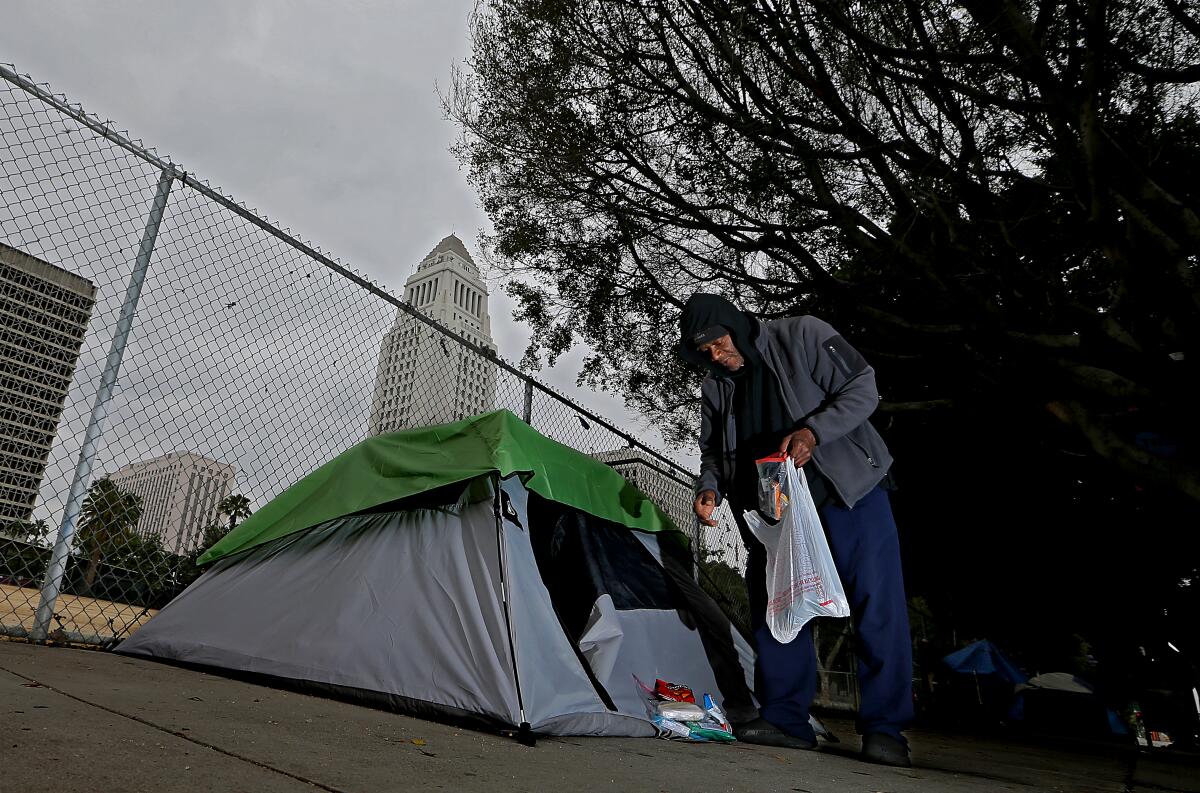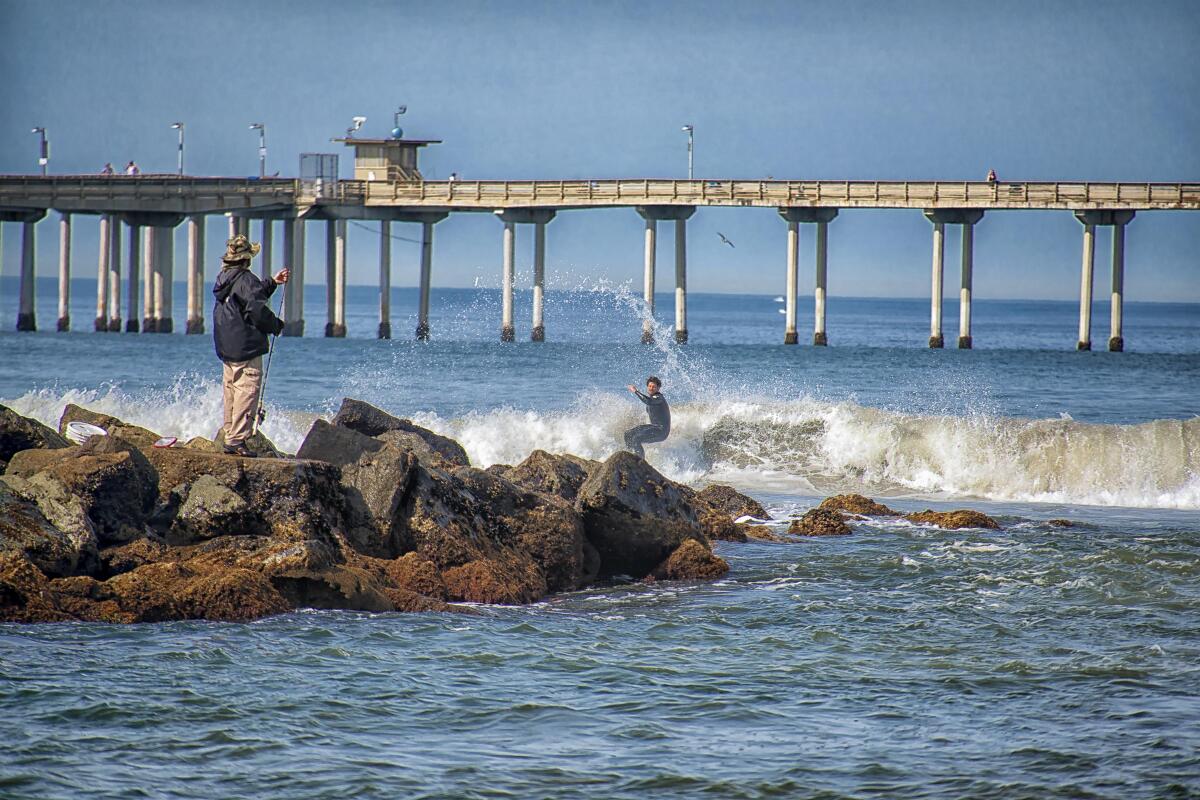Study traces ‘causes and consequences’ of California homelessness — and challenges myths

- Share via
Good morning, and welcome to the Essential California newsletter. It’s Wednesday, June 21.
The lives of California’s unhoused population are as complex and nuanced as those of anyone else. That doesn’t sound like a radical statement, but in conversations about homelessness, it can be.
A newly released study from UC San Francisco’s Benioff Homelessness and Housing Initiative aims to explore that truth with a comprehensive account of “the causes and consequences of homelessness in California,” according to its authors.
Researchers surveyed nearly 3,200 people experiencing homelessness across eight counties in the state, using their answers to create representative statewide estimates. They also conducted in-depth interviews with 365 of those participants.
The study found that nearly half (47%) of all unhoused adults in the state are 50 or older, with Black and Native American residents “dramatically overrepresented.” Notably, 41% of that share became homeless for the first time at 50 or older.
For Times columnist Anita Chabria, the report demonstrates that California’s income inequality has reached a point where “if you are older and unable to work, homelessness is a real threat throughout the Golden State.”
“As much as we want to see the average homeless person as a drug tourist dropping into too-progressive cities for the good fentanyl and lax laws ... or someone whose mental illness makes it impossible for them to live unaided, the truth is simpler — and much more devastating,” she wrote this week. “As Californians age, they are being priced out of housing.”
The study breaks down the many factors that people pointed to as contributing to their homelessness. The top reason cited was a loss or reduction of income. Researchers also broke down the primary reasons cited by both leaseholders and non-leaseholders — participants who didn’t have their name on a lease or mortgage before their most recent episode of homelessness. Non-leaseholders were more likely to report social reasons — such as conflicts with other residents or discrimination — while leaseholders pointed to economic reasons. Fleeing domestic violence was one common reason for both groups.
The authors also pointed to a few misconceptions about homelessness, including “myths of homeless migration.”
According to researchers, “90% of participants lost their last housing in California and 75% of participants live in the same county as where they were last housed.”
The research highlights the complex trajectories that lead to homelessness, but also presents compelling evidence of something advocates for the unhoused have long been saying: Poverty is in many cases the original sin. Traumatic experiences can intensify a person’s mental health and substance use — which affect an array of people regardless of their housing status. But add the stress and trauma of living on the edge of financial ruin and a vicious spiral begins to take shape.
The authors also highlighted several solutions in the form of government policy, namely confronting the lack of affordable housing for Californians living in extreme poverty.
“In 2023, California had only 24 units of housing available and affordable for every 100 extremely low-income households,” the study states.
Recommendations include:
- Mitigating the often-sudden housing loss people experience by investing in more rent subsidies and mediation to avoid evictions
- Responding more swiftly when people lose housing to connect them with vital services and lessen their time on the streets
- Increasing access to substance use treatments and harm reduction service outreach
You can explore the full report here.
And now, here’s what’s happening across California:
Note: Some of the sites we link to may limit the number of stories you can access without subscribing.
L.A. STORIES
The pandemic-sparked remote work revolution has had a dramatic effect on downtown L.A.’s once-bustling financial district. “While the neighborhood shows signs of recovery,” my colleague Roger Vincent writes, “few expect it to return to being the bustling hive of suits and ties that it was.” Los Angeles Times
After months of mostly gloomy skies, the sunshine is back in L.A. to mark the start of summer. Today marks the summer solstice, a.k.a. the longest day of the year. If you’re looking to get out and kick off the new season, here are 11 spots across the county for a picnic. Los Angeles Times
POLITICS AND GOVERNMENT
California’s insurance woes are reaching our cars. That’s according to insurance agents who report difficulty securing quotes for clients who they say would have easily been covered last year. San Francisco Chronicle
Florida Gov. Ron DeSantis, fond of lobbing insults at California and its governor, visited Gavin Newsom’s home turf this week. DeSantis was in Sacramento to make his pitch to California Republicans and raise some money for his 2024 presidential election bid. The New York Times
CRIME, COURTS AND POLICING
A man accused of killing two women in Ventura County was convicted of involuntary manslaughter and received the maximum prison sentence for the crimes on Tuesday — and was released from custody the very same day. That’s because a state law gave Shawn Shirck, now 29, an added day of credit for time served as he sat in jail for nearly four years while the case experienced pandemic delays. Los Angeles Times
California Atty. Gen. Rob Bonta announced a new plan to crack down on organized retail crime in the state. His office is partnering with the Justice Department and more than a dozen retailers and online marketplaces to increase information sharing in a bid to strengthen evidence for prosecutions. Los Angeles Times
Support our journalism
HEALTH AND THE ENVIRONMENT

A bloom of toxic algae has sickened or killed more than 1,000 marine mammals along Southern California’s coast this month, including hundreds of sea lions and dozens of dolphins. High concentrations of a neurotoxin produced by the algae have been reported in waters off Ventura and Santa Barbara counties. Los Angeles Times
Construction kicked off Tuesday on a Wyoming wind farm that’s set to be the largest in the U.S. — and to provide a direct line of wind energy to Southern California. The Equality State actually exports the majority of the electricity it produces (wind or otherwise), and its growing supply of wind power is a boon for California and other Western states that have mandated switches to clean energy. Associated Press
CALIFORNIA CULTURE
Some UCs and other elite universities may have name-brand draw, but a new analysis of federal data shows graduates of community colleges and CSU schools sometimes draw considerably larger salaries than their counterparts. The findings, writes Times education reporter Teresa Watanabe, highlight a “growing scrutiny over the value of college degrees — and whether higher education is worth the rising costs.” Los Angeles Times
What would you do if the dog you adopted to provide a better life attacked someone? Writer Michelle Madden chronicles the journey she and her rescue dog Buddy took to find healing and stability after a harrowing experience. Los Angeles Times
Free online games
Get our free daily crossword puzzle, sudoku, word search and arcade games in our new game center at latimes.com/games.
AND FINALLY
Today’s California landmark is from Terry Ogden of Visalia: Ocean Beach in San Diego.

Terry writes:
The scene reminded me of many trips to California beaches from north to south: pier, surfer, fisherman — all in one frame.
What are California’s essential landmarks? Fill out this form to send us your photos of a special spot in California — natural or human-made. Tell us why it’s interesting and what makes it a symbol of life in the Golden State. Please be sure to include only photos taken directly by you. Your submission could be featured in a future edition of the newsletter.
Please let us know what we can do to make this newsletter more useful to you. Send comments to [email protected].
Sign up for Essential California
The most important California stories and recommendations in your inbox every morning.
You may occasionally receive promotional content from the Los Angeles Times.




